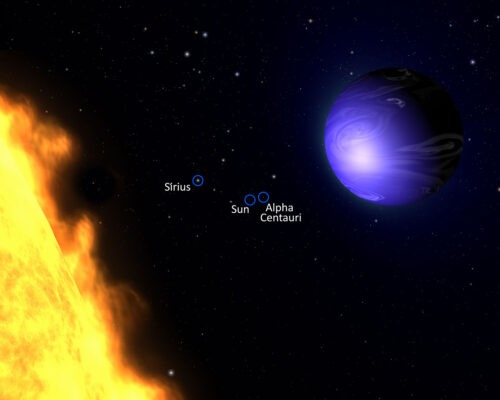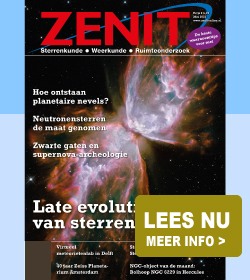This illustration shows a “hot Jupiter” planet known as HD 189733b orbiting its star, HD 189733. The NASA/ESA Hubble Space Telescope measured the actual visible light colour of the planet, which is deep blue. This colour is not due to the presence of oceans, but is caused by the effects of a scorching atmosphere where silicate particles melt to make “raindrops” of glass that scatter blue light more than red light. Because the planet is only 63 light-years from Earth, a visitor would see many of the same stars we see in our nighttime sky, though the constellation patterns would be different. Our Sun and the nearest star to our Sun, Alpha Centauri, are labelled here
Astronomisch nieuws, wetenswaardigheden én persoonlijke opinies
Recente berichten
- Hubble constante bepaalt met behulp van supernova H0pe
- Fermi ziet geen gammastraling van de supernova die vorig jaar in M101 verscheen
- Het uitdijende heelal thermodynamisch bekeken
- Zwaarste stellaire zwarte gat in ons Melkwegstelsel ontdekt
- Neutronensterren kunnen ons meer vertellen over donkere materie
Archief Astroblogs per maand
Meest gebruikte Astroblogs tags
67P
ALMA
astrofotografie
Cassini
Chandra
clusters
Curiosity
donkere materie
ESA
ESO
exoplaneten
Higgs bosonen
Hubble
infografieken
ISS
Jupiter
JWST
Kepler
kometen
LHC
maan
Mars
Melkweg
Mercurius
NASA
New Horizons
planetoïden
Pluto
pulsars
Rosetta
Saturnus
Sojoez
SpaceX
sterrenstelsels
stervorming
supernovae
superzware zwarte gaten
Venus
VLT
water
Webb
witte dwergen
zon
zwaartekrachtgolven
zwarte gaten
Copyright © 2024 · Genesis Framework · WordPress · Log in



Speak Your Mind